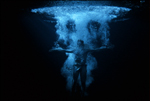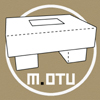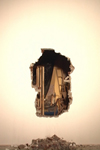SPAZIO OBERDAN
Spazio Oberdan
October 28th 2005 - February 26th 2006
Artists have always used every technique available at a given time. Art and technique have always been an inseparable couple, so strictly related one to the other that ancient Greeks had olny one word to name them: it was techne. Since 1999, Techne is a biennial exhibition dedicated to the connection between art and technique. It intends to prove, and enjoy, the creative and innovatory use artists can make of the state-of-the-art techniques, above all the diogital ones. Techne allows to take a fascinating trip in the world of images: not only to admire them, but also to plunge into them, play with them, and experiment the weaving between vision, hearing and action. At the Spazio Oberdan we'll find an up-to-date survey of video installations, from the classical to the most extreme ones: the ones which prove able to cast the image "beyond the screen", and to create the pleasure of vision, but also a shining and firm language innovation.
| Bill Viola, Ascension | |
 |
Bill Viola is one of the best known and popular video artist. He shows a video installation never presented in Italy until now, that achieves rigorous precision and simplicity. Like many Viola's works, Ascension is a total environment, which shelters the viewer in image and sound. We are uncertain if that body floating is dead or alive, but its movement and the sound rock us in an almost hipnotic way. And the sudden end remind us the timeless cycle of life and death. |
| Agon, Phases | |
 |
Phases, or: how the participant's behaviour can affect the work. The dancer's rhythm changes according to the viewer's greater or shorter distance from the monitor. The viewer's movement generates differences, and the differences generate selw-awareness. This is a refined proposal by AGON group, which is looking since 15 years for innovative forms of music, image and theater. |
| Alessandro Amaducci, Spoon River | |
 |
In this installation one of the most active and fecund Italian videomakers shows a stylised but precise reconstruction of the daily settings for six characters from Spoon River Anthology. Amaducci's reinterpretation doesn't hide Edgar Lee Master's poetic text, on the contrary it combines it with images and setting, looking for the "contemporary in the past" that constitutes the work's fascination. |
| Antonella Bussanich, Il mondo d'oggi | |
 |
This is a journey among european youths, who answer with a single word to a sudden question about today's world. The installation is built around circular structures and movements. By asking young people "What's the first word that comes to mind when you think of today's world?", Antonella Bussanich did not intend mainly to raise a debate, but rather, as she said, "establish an eye contact, if only for a brief instant, with the subject". |
| Mario Canali, M.OTU - Virtual Sumo | |
 |
Mario Canali has designed on purpose for Techne this installation, which is the last step of a long-attended research about sensorial and bodily interactivity. In this virtual version of the national Japanese sport, the unconscious is more important than intention: through sensors which record the player's emotional state, computer interprets body signs, as the wrestlers do in the real play. |
| Luiz Duva, Demolizione | |
 |
In this interactive video installation by the Brazilian video artist and VJ, there is more than sheer entertainment. The screen shows itself to be a wall: every time the visitor pushes the button, a split opens up in the wall, till it is completely demolished. Luiz Duva suggests that behind the projected surface there is a volume: the screen only exists to point out what lies beyond. |
|
Terry Flaxton, The Dinner Party (Il pranzo) in collaboration with British Council |
|
 |
Terry Flaxton's shrewd and paradoxical installation contributes to the deconstruction of traditional video. The restless and versatile british filmmaker refuses usual interactivity, and displays, instead of a normal screen, a laid dinner table; then invites the viewer, through a very precise projection, to try to match the virtual fellows' gestures. An unforeseeable and bewildering end follows. |
| media_FORMASUONO, Capriccio spaziale | |
 |
Here we are in the domain of sheer synesthetics that is, the exchange between different sensorial experiences. "The question which is to be posed to the hearer is not 'what do you hear?', but 'what do you see?'", writes Francesco Rampichini, who invented the term "acousmetry" and is author (alongside with Ettore Lariani and Marco Maiocchi) of this installation. We are invited to "see" and "draw" sounds, through an ingenuous but immediate code that links geometric shapes to sounds. |
| Andreas Sachsenmaier, L'ultima cena in collaboration with Goethe-Institut Mailand and Grohe Water Technology |
|
 |
Here is an example of a manner very deeply "German". We say "upsetting" or "disturbing", they say "unheimlich", that is "not familiar". As Freud explained in a well known essay, it means that in an image or a situation we believe to know rather well something stranger creeps. L'ultima cena: there's the table, there's the perspective, there's the light. But where the guests come from? What have those ladies, all so televisional, to say? What is that off voice telling? |
| Studio azzurro, Dove va tutta 'sta gente? | |
 |
They don't knock politely, they don't ask as well-mannered people. They crowd, they press, they want to come in. Shocking images getting to reflection. Studio azzurro suggests that every boundary (the physical ones between the nations, and the immaterial ones, like those between natural and artificial) are brought up in discussion in this time. This installation tells us destinies and desires of peoples which meet and clash, in one of the most fascinating metaphors of globalization yet produced by art. |

